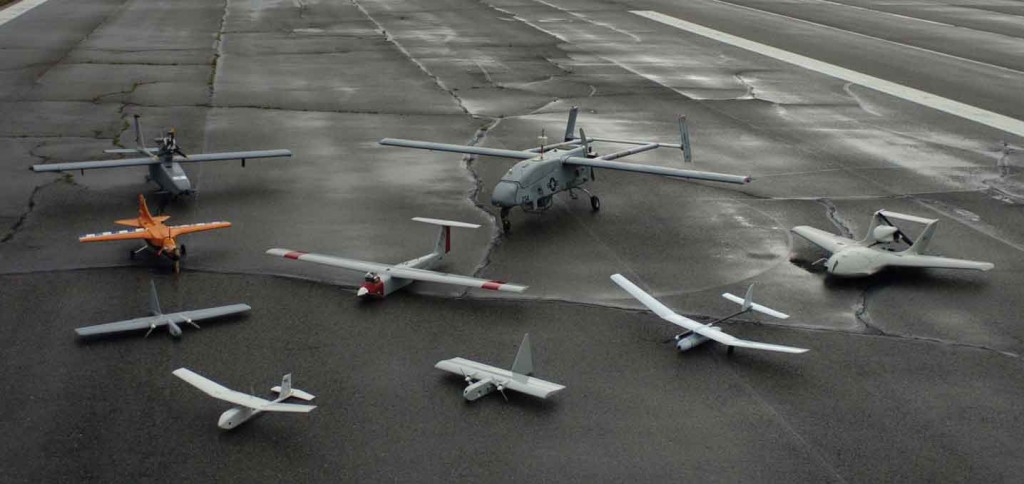
Various Unmanned Aerial Vehicles. Pictured are (front to back, left to right) RQ-11A Raven, Evolution, Dragon Eye, NASA FLIC, Arcturus T-15, Skylark, Tern, RQ-2B Pioneer, and Neptune.
Having celebrated the centenary of manned aviation just eight years ago, it will be time to celebrate the 100th anniversary of unmanned aviation on March 6, 2018. Unmanned aviation encompasses a wide range of airborne platforms, from an ‘aerial torpedo’ or the forerunner of today’s cruise missile to the futuristic astral-planes being developed to explore other galaxies. Other machines include aero models, target drones, decoys, reconnaissance as well as armed platforms; which are commonly known as Unmanned Aerial Vehicles (UAVs). With a variety of dangerous’ missions presently flown by combat pilots both fixed and rotary wing, being taken over by robotic flying machines, the new terminologies with a wider connotation to replace UAVs are Unmanned Aircraft Systems or Unmanned Aerial Systems (UAS).
The development of unmanned aircraft hinged on integration of three critical technologies namely automatic stabilisation, remote control and autonomous navigation. Elmer Sperry of USA was the first to attempt an unmanned aircraft design to incorporate the three features on a single platform. The efforts resulted in the invention of the Aerial Torpedo. Efforts in the US and UK to design radio controlled recoverable aerial targets materialised with a successful flight in September 1924. Target drones were introduced in 1930 as a spin-off of these early efforts. Prior to World War II, target drones were in use in both the countries to train anti-aircraft gunners. Interestingly, some of these were assembled by a 19-year old employee, Norma Jean Dougherty, who later became famous as Marilyn Monroe.
The USAF has initiated a program to develop the Next Generation Unmanned Aerial System (NG-UAS). In May 2009, the industry was notified by the USAF that it seeks a follow-on UAV to the highly successful MQ-1 Predator and MQ-9 Reaper…
In later years, unmanned aviation progressed rather slowly with the USAF using these mainly as reconnaissance drones in the Vietnam War. Although research on miniaturization incorporating inertial navigation GPS and data-link continued, it was the Israel Defence Forces that were the first to exploit these capabilities. In the Yom Kippur war of 1973 in the Golan Heights, Israel used UAVs to obtain critical information on the advancing Syrian armour, which helped them to set up ambush and achieve a decisive victory despite numerical superiority of the enemy. However, the true potential of the UAV was understood only after the operations in Bekaa Valley in 1982, wherein the Israelis employed UAVs as “force multipliers” in varied roles such as reconnaissance, spoof missions and Electronic Warfare.
Future Trends
As the Centennial year of UAV approaches, a number of countries have already launched futuristic programmes with advanced technologies are being incorporated for size, shape and payload. The USAF has initiated a program to develop the Next Generation Unmanned Aerial System (NG-UAS). In May 2009, the industry was notified by the USAF that it seeks a follow-on UAV to the highly successful MQ-1 Predator and MQ-9 Reaper, the latter a much improved variant of the Q-1 series. UAVs with the prefix ‘M’ indicating multi-mission capability, proved invaluable in operations in Afghanistan and Iraq.
Then there is the US Defence Advanced Research Projects Agency (DARPA) project to develop the ‘Vulture’, a UAV that would have an enormous endurance of five years. Recent news reports indicate that the development programme has entered second phase. Details of the design or the type of fuel it would use for a five-year endurance are however not available.The NG-UAS platform is planned to have capabilities beyond existing UAVs. Compared to the MQ-1 Predator which first flew in 1994 and the derivative MQ-9 Reaper of 2001 vintage, the new vehicle would have improved manoeuvrability and time-on-station among other features. The planned initial operationalisation of the NG-UAS would be 2015. General Atomics has already developed a candidate for the NG-UAS role now known as Predator-C. This UAV is believed to have swept-back wings and stealth characteristics. Other firms, notably Northrop Grumman, which produces the highly successful RQ-4 Global Hawk UAV as well as several other firms are expected to enter the competition for the NG-UAVs. With all-weather and triple- redundant avionics and 70 hours of endurance, the Israeli UAV ‘Eitan’ holds great promise. Eitan is capable of carrying payloads of 2000 lbs. Solar powered UAVs under development will facilitate long duration stealth flights at high altitudes., Surprisingly Russia has been a somewhat late entrant in this field And nhow has launched an ambitious programme for tactical UAVs.…the proposed supply of 12 Predators to Pakistan has raised concerns in India. Although US officials had mentioned that the Predators would not be armed with Hellfire or other such air-to-ground missile…
The Chinese have made steady progress in this field over the last decade. Over 40 UAV models were displayed at the Zhuhai air-show in mid-November 2010. These included both fixed and rotary wing designs aimed at not only intelligence, surveillance and reconnaissance applications but for strike role as well.
Increasing Combat Role Two years ago after an intense debate, President Obama had agreed to incremental increase in the strength of US troops in Afghanistan. However, what may have gone unnoticed is the manifold increase in the use of Unmanned Aerial Systems (UAS). USAF is using a wide variety of such platforms in Afghanistan for combat-support as well as for remote delivery of PGMs and other weapons, over unsuspecting targets. As regards this big ‘surge’ in Iraq and in Afghanistan in particular of robotic planes, it is reported that there has been a 120 per cent increase in UAS flying as compared to in 2006, Similarly the numbers of Predators and the resultant missile attacks have also grown exponentially.
The reach and lethality of UAVs are such that the proposed supply of 12 Predators to Pakistan has raised concerns in India. Although US officials had mentioned that the Predators would not be armed with Hellfire or other such air-to-ground missile, it will not be too difficult for Pakistan to do so with clandestine assistance from another source. Pakistan already has ongoing UAV development projects with China, Turkey and South Africa.
The US has now offered Pakistan the smaller Scan Eagle UAV, which has a longer endurance. It weighs 18 kg , has a three metre wingspan and uses a new video technology (Pixon Vision) that provides better resolution. The Scan Eagle can stay in the air for up to It has an endurance 15 hours and fly as high as 5,200 meters. The aircraft carries an optical system that is stabilised to keep the cameras focused on the target while the UAV is in flight.
Development of UAVs in India
The Indian Air Force (IAF) inducted the Searcher II and Heron UAVs in the year 2000. These have performed well over the past few years delivering electro optical/infrared (EO/IR), EW and Synthetic Aperture Radar (SAR) intelligence. The IAF has been able to exploit ground and airborne relays to extend operating range and also using them over different terrains including the Himalayas. Op Parakram provided the IAF the opportunity to develop the expertise to reduce ‘sensors to shooter’ cycle. On the other hand, deployment in different parts of the country enabled the IAF to acquire additional infrastructure which will help in exploiting UAV in different roles such as disaster management including detection of leaked radiation as in Fukushima, Japan recently and for internal security. The Indian Army and the Indian Navy have also procured similar platforms enabling commonality in training, infrastructure and maintenance.
It is also estimated that the memory capacity of a computer will equal that of the human closer to 2030. Hence the opportunities of futuristic applications of UAVs are phenomenal.
The IAF has been able to exploit ground and airborne relays to extend operating range and also using them over different terrains including the Himalayas.As regards the indigenous programmes, in early 1980s, the IAF used remotely operated targeting drone Chakor, an improved version of the Northrop Chucker RPV,. However, development of the DRDO derivative Lakshya was delayed. However, with recent modifications to the tow body and the engine, its performance has improved considerably including for practice firing of BVR missiles. On the other hand, another catapult launched UAV Nishant has made good progress with a new Wankel engine. This will pave way to the advanced version Gagan, which will also carry an SAR payload. DRDO has now embarked on a comprehensive programme for varied types of indigenous UAV. DRDO has successfully test flown Rustom-1, a Medium Altitude Long Endurance UAV, the second time in October last year. It has also developed a Micro-UAV named Netra, specifically for anti-terrorist and counter insurgency operations. This 1.5 kg UAV is a collaborative development project between DRDO and alumni of IIT, Mumbai and has the potential to operate in all the conflict theatres, including urban scenarios similar to that of the 26/11 terrorist attack.
Presently the various roles for which UAVs are being utilised by the IAF are intelligence gathering including reconnaissance and surveillance, UAV assisted fighter /helicopter strike (UAFS/UAHS) as well as laser designation of targets. UAVs are also used for Battle Damage Assessment (BDA) and for real time inputs to aircraft on strike missions. Use of SAR and IR gives this platform near all-weather capability. UAVs are also used for ELINT and using the inputs along with COMINT to evade and intercept enemy fighters and helicopters. Other role being considered is a weapon platform like the American Predator, paving way to UCAV in the future.
The unmanned systems acquired by the IAF have been continuously upgraded. Add-ons such as Automatic Take Off and Landing systems, satellite communication data-links, better radio relays and advanced payloads are also being contemplated. It is a versatile platform, a force multiplier and hence it needs to be accorded the necessary impetus for attaining integrated operational status.
It is reported that the US armed forces fly more than 350,000 hours annually on UAV and nearly half the total air effort in Israel is on such remotely operated platforms. With numbers of UAVs on the increase, indigenisation assumes greater importance. India needs to develop capability to develop large platforms like the Global Hawk, stealthy X-47B, armed Predator, SR-30 Rotary and the 6-inch long Micro UAV, Black Widow.
It is heartening to note that not only is the DRDO collaborating with aerospace majors, but the Indian private industry along with foreign partners has also entered this field. Backed by India’s expertise in software, concerted efforts in manufacturing UAV and necessary ground support equipment, would greatly benefit the military and civil users alike. Need of the hour is to get down to serious implementation of the current as well as future programmes. If we do not , it may well be a repeat of other delayed projects like LCA or IJT and we will be shackled forever to imports.
With no possibility of human casualty and marginal investment compared to a manned aircraft, for proving the basic fly-worthiness of the platform; UAV developmental programmes are very cost-effective, some of them being developed in the ‘back-yard workshops’. It is time to use IITs and other technical institutes for innovation and also use private sector industries for marketing.
Moore’s Law predicts that the speed of microprocessors will reach parity with the human brain around 2015. It is also estimated that the memory capacity of a computer will equal that of the human closer to 2030. Hence the opportunities of futuristic applications of UAVs are phenomenal. UAVs will evolve from being remotely operated to independent robots, able to self actualise the task. But such ultimate autonomy will require capabilities similar to the human brain in terms of speed and memory. As to how many lines of software code equate to ‘thinking’ is still not clear, but indigenous capability in Robotics and Artificial Intelligence will need to be developed rapidly so as not to miss out the next RMA.
Operational Paradigms
Driven by the rapid growth in micro and nano technologies, manufacturers of UAVs are developing payloads and synergetic support systems both for military and non-military applications. The latter would include applications such as counter terrorism operations, disaster management, border and urban surveillance, ground and sea traffic monitoring, crop diagnosis and insecticide spraying, ground mapping to name a few. Unmanned Systems being technology intensive, their exploitation poses a number of challenges. With the anticipated expansion of UAV fleet these will need to be addressed holistically.
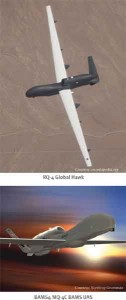 Some of these are Human Resource Management, Interoperability with other Platforms, Standardisation of Unmanned Systems, Communications, Network Centric Operations and Air Traffic Management to name a few. A large team of highly skilled and motivated operators and maintenance crew are required on the ground to operate UAVs that have marginal error tolerances especially in during take-off and landing, evading enemy interception and during emergencies such as loss of link. UAVs are ideally suited for long duration sorties requiring multiple sets of crew for round-the-clock operations. In the future to operate UCAVs, it is essential that all HR issues such as selection, training, work ethos, CRM as well as career progression be reviewed. Use of simulators for would help reduce training period especially for the External Pilot (EP) and also help in promoting CRM for coordinated actions during emergencies.
Some of these are Human Resource Management, Interoperability with other Platforms, Standardisation of Unmanned Systems, Communications, Network Centric Operations and Air Traffic Management to name a few. A large team of highly skilled and motivated operators and maintenance crew are required on the ground to operate UAVs that have marginal error tolerances especially in during take-off and landing, evading enemy interception and during emergencies such as loss of link. UAVs are ideally suited for long duration sorties requiring multiple sets of crew for round-the-clock operations. In the future to operate UCAVs, it is essential that all HR issues such as selection, training, work ethos, CRM as well as career progression be reviewed. Use of simulators for would help reduce training period especially for the External Pilot (EP) and also help in promoting CRM for coordinated actions during emergencies.
Next is the issue of Interoperability of UAV with other platforms including strike aircraft and helicopters. The ability of this system to exchange data with other systems has been proved beyond doubt. Interoperability has been demonstrated recently in Operation Enduring Freedom, conflicts in Lebanon and in the war in Afghanistan. With tools at hand for Network Centric Operations (NCO), the IAF too is capable of streaming live videos for all C4I2 users along with provision of ESM data. Successful trials reveal that ESM and SAR imagery can be very usefully integrated. Due to its wide coverage, long endurance and the capability to loiter in the AOR, use of UAV can be exploited with synergy of effort. Multiple payloads will allow this vehicle to locate and designate hostile emitters, with live video streaming for any Commander to decide and shape the battle. The present usage of this platform is a stepping stone for more complex and interwoven air campaigns in which UAV will be the eyes of any commander. A Predator type of armed option will further enable reducing the OODA loop to near real time engagement in the battle field.
…growth of the UAV fleet of the three services is likely to increase by 100 per cent in the next five years and nearly fivefold in the next decade. With several UAV manufacturers waiting to flood the Indian military and civilian markets…
Based on requirements projected by the Armed Forces, UAV designers and manufacturers in Europe and the US are already working on common architecture to enable System Interoperability. Induction of similar UAV Systems by the Indian Armed Forces has accentuated the need for standardised system architecture for all existing and future UAV Systems. Since the three Services are presently operating UAV manufactured by a common OEM, all ground stations, data terminals and their architecture are similar. However, growth of the UAV fleet of the three services is likely to increase by 100 per cent in the next five years and nearly fivefold in the next decade. With several UAV manufacturers waiting to flood the Indian military and civilian markets in the years ahead, a requirement of interoperability with common standards/architecture is the need of the hour. Standardisation resulting in effective interoperability would help find solutions to issues such as constraints of bandwidth, airspace management and mobility. Standardisation would help in focussing effort and create competition, which are two crucial elements, needed to accelerate technological progress. Standardisation will help in reducing training costs, decreased programme risk, increased interoperability and lower operating costs.
Next are the present limitations of reliable navigation and seamless data-link. These are prerequisites for the UAV to undertake complex missions aimed at manoeuvring in a restricted tactical area with limitations of terrain and in urban areas. It is practically impossible to obtain a miniature, lightweight solution which operates over relatively long ranges and can be used as a robust, autonomous system. While using ground based data-links, the Ground Control Stations (GCS) and their Data Terminals have to be sited to give maximum unhindered coverage. Though this aspect could be ignored in flat, open terrain, it assumes significance in areas with uneven terrain/tall buildings or trees in close proximity of the GCS site. LOS limitations may also dictate deployment of additional GCS in forward locations to observe targets.
However, this may not be feasible in a rapidly changing tactical scenario. Satellite data-links also have inadequate indoor/urban accuracy due to multi-path signal, refraction, diffraction, sky-wave affects and absorption. In UAV operations, an enormous amount of data exchange is inevitable. During this process apart from reliability, secured communication, protocols also become extremely essential. Therefore use of multiple paths for transferring data from the controller to sensor to the recipient, would enable seamless exchange of data ensuring success of the mission. Towards this, a ‘Multiple Path User Network (MULPUN)’ would need to be put in place. This network could utilise the existing hardware for dedicated data-links and add-on satellite data-links, as well as create a VPN using existing cellular networks and portable convergence routers.
Airspace Management
With increasing numbers of UAV both in military and civilian use, airspace management is another challenge which will need to be addressed. Since military UAV like the Global Hawk are flying in air space common to Civil Aviation traffic, FAA and Euro Control have already drafted regulations to help in air traffic management. Developing on the concept of ‘sense and avoid’, Russia has also issued instructions for UAV operations, based on the use of transponders using Global Navigation Satellite System (GNSS). In order to understand the nuances, a concept of Optionally Piloted Air Vehicle (OPAV) is being developed.
Think of a scenario wherein a wanted mastermind is celebrating a successful terrorist attack and regaling the celebrity status in media coverage. Suddenly clutching at his throat, the mastermind is gasping for air, with death moments away.It is something in between a piloted aircraft and UAV. While Bell Company has a helicopter OPAV already flying, so are Russian ‘Irkut-850’ and German Stemme S-10 VT fixed wing OPAV. These not only serve as excellent ‘flying laboratories’ to explore newer technologies and concepts, but also help in solving issues such as certification, standardisation and formulation of air traffic regulations. Since the UAV are quite susceptible to adverse weather conditions, OPAV could also help in developing procedures and limits for weather penetration.
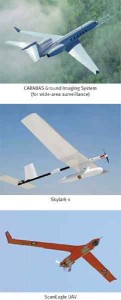 With increasing number of such platforms there is this aspect of Airspace Management. One of the major causes of losses of aircraft over Afghanistan has been collision with smaller, low-flying UAVs. Israel had to pay special attention to this aspect during the war in Lebanon in 2006ah, which witnessed crowded skies with combat aircraft, helicopters and UAVs generating over 400 sorties a day in a small area of operations. Some of the countries have therefore incorporated IFF on UAVs for airspace management, an aspect the IAF needs to also consider expeditiously.
With increasing number of such platforms there is this aspect of Airspace Management. One of the major causes of losses of aircraft over Afghanistan has been collision with smaller, low-flying UAVs. Israel had to pay special attention to this aspect during the war in Lebanon in 2006ah, which witnessed crowded skies with combat aircraft, helicopters and UAVs generating over 400 sorties a day in a small area of operations. Some of the countries have therefore incorporated IFF on UAVs for airspace management, an aspect the IAF needs to also consider expeditiously.
The Future
As it approaches its centennial in 2018, unmanned aviation points towards an impressive future. Think of a scenario wherein a wanted mastermind is celebrating a successful terrorist attack and regaling the celebrity status in media coverage. Suddenly clutching at his throat, the mastermind is gasping for air, with death moments away. In the ensuing chaos, none has noticed a small honey-bee like flying creature firing a poisoned dart; controlled remotely from thousands of miles away.
May be fiction now but with nanotechnology and other capabilities like solar powered flutter wings and multiple communication channels, it may not be too far into the future that one could witness a scenario such as this.




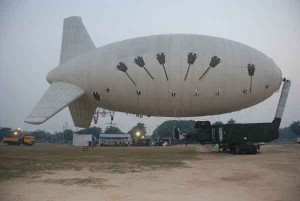
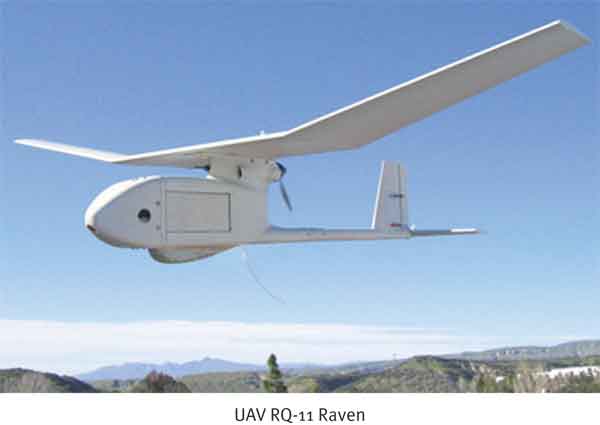

My son is interested in doing the ” Unmanned aerial vehicle course ” in India. Any suggestions ? Thanks
Thanks for the updates Sir. If some articles on UCAVs can be published.
Dear Sir,
I do fully realise and understand of the above siad facts.
More than anything else our arsenels should be ready with full preperation with constant, susuained and fully dedicated war factors from three major components Air, Army and navy. This must be suitably and preperatually supported, instigated and supported by our para defences like ITBP, BSF and CRF The role of IB, RAW and other local intelligence is also indespensible and imperative.
Preparation depends on regular mopck drill, excercise under various conitions and simulated excercises.
We can be worried but that must not stop our available defense-power.
G Ramani Iyer